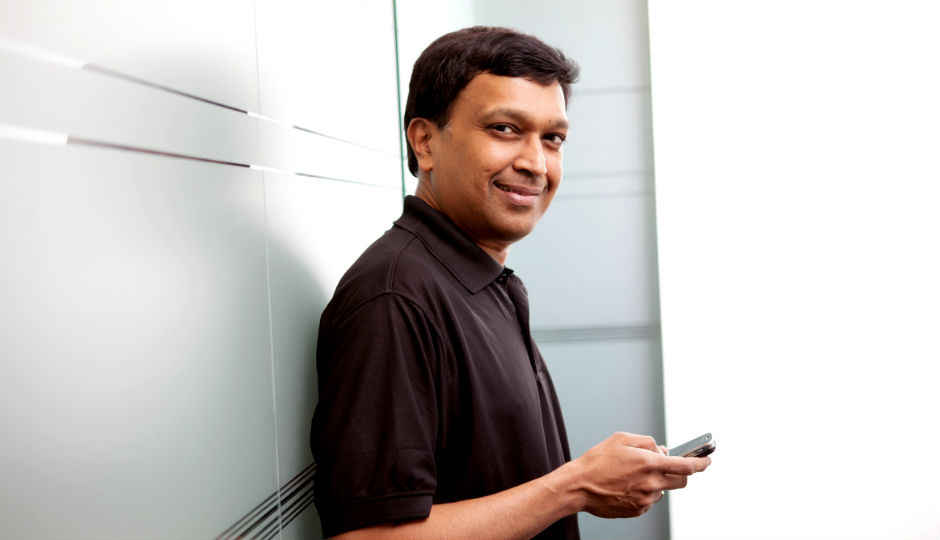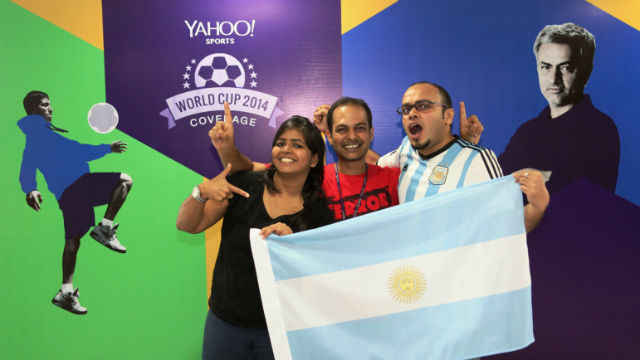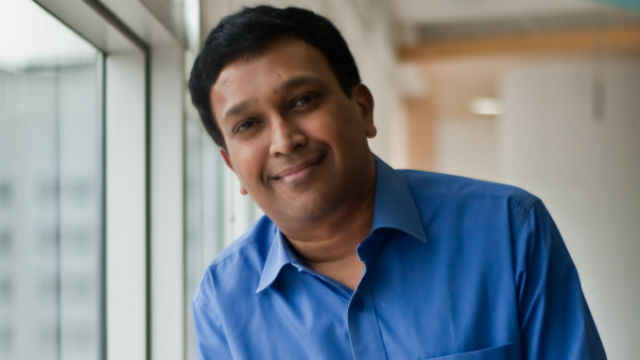Demystifying the cool new Yahoo with Hari Vasudev

One of the oldest, most homely destinations on the Web, Yahoo has cleaned its cobwebs and turned a new leaf. Full of renewed vigour and dynamism, the company is starting to wow users once more, and win over new ones. We spoke to Hari Vasudev, VP & Head, Yahoo India R&D, about how Yahoo is changing under Marissa Mayer, the innovative products it's building and the bold new direction it's headed.
Q) How have things changed under Marissa Mayer?
Hari: Overall, since Marissa’s come on-board, we’re treating this very much as a marathon with a combination of series of sprints. The idea is to show momentum across all of our product launches. And we think there are four pillars to this whole process that Yahoo’s embarked upon. First is People, and specifically the plan is to get the right people into the right roles within the company and make sure that nothing standing in the way of execution, to be able to drive innovation across all our products and making sure that they’re being as productive as they can be. The second pillar is Product focus, and quickly launch the most innovative and best of breed products with a specific focus on mobile.
With the right people in the right roles and by building world-class products that are extremely innovative, which our consumers love because they’re very enriching and extremely beautiful, all this will result in tremendous increase in traffic (which is the third pillar) and that’s already happening. As of June 2013, after many quarters of decline, we actually see traffic pick up and grow. And this is both in terms of daily users, page views and engagement matrix across all of our major properties. Today we have over 800 million unique visits per month, without counting Tumblr – add Tumblr into the mix and that’s over 1 billion unique visits a month. There’s been tremendous traffic growth and in fact in August 2013 Yahoo was the #1 publisher in terms of traffic, as per ComScore.
After the build up of the products and the traffic, the fourth pillar is to focus on revenue. This year there’ll be a big focus on driving revenue and there are good signs on that front as well, because in Q1 2014 we saw an increase in our quarterly revenue (for that quarter) since 2010.
Apart from these four pillars, the overall momentum that Marissa’s created, especially working with the leadership team to drive a cultural transformation across the company. From things like free smartphones (for employees) to dramatically increasing the transparency within the company, from how employees work collaboratively with each other to redesigning the workplace for teams to work like startups, all geared towards quickly building and launching products. She’s ensured on one hand that there’s nothing standing between people being as productive as they can be, but on the other hand focusing on the culture and making Yahoo an innovative and fun place to work at. This combination has translated into a tremendous amount of momentum across our products, which then has led to increased traffic and obviously increased revenues.
Q) How has the people at Yahoo India contributed to Yahoo’s recent global success?
Hari: We at Yahoo India R&D don’t think ourselves as a separate entity from Yahoo global, for instance, and it’s important to understand this difference. All of our teams are very tightly integrated across geographies, especially given the extremely collaborative nature of how we work together. All of our teams here in Bangalore are very tightly interwoven with global teams, and they have been heavily involved in a number of recent Yahoo product launches. To give you a couple of specific examples, with respect to the FIFA World Cup coverage, that’s something that our teams in Bangalore have been very actively working on. They’ve been instrumental in building a truly world class World Cup experience for users globally (25 countries and 11 different languages through Yahoo’s sports website and mobile apps), not just in India. We also have teams working in areas as diverse as Yahoo Groups, and others working on Yahoo’s platform products for content ingestion by helping Yahoo sites worldwide have the best content for display in a very personalized way. Point is that we’ve teams that span multiple initiatives, that work in very closed collaboration with their counterparts within rest of Yahoo – that can be anywhere from the US to our Taiwan hubs.
Yahoo India R&D – a software development arm, which is what I look after – is very tightly integrated with Yahoo global, per se, whereas Yahoo India – which is the sales and business entity – is a separate legal company based here, not connected to Yahoo India R&D. Yahoo India’s responsible for selling the products that we (Yahoo India R&D) builds, specifically for the India market.
Q) Mobile is big on everyone’s radar these days. How’s Yahoo attacking the mobile space?
Hari: If you look at countries like India, most first-time Internet users browse the web on their mobile device. This can be a tablet, smartphone, or in countries like India, even feature phones. So our effort is to ensure that we’re very much a mobile first company. If you look at some of the 40 odd acquisitions we’ve made since Marissa’s come onboard, many of them have been with the view of building a very strong mobile talent base within the company. Even if you look at Tumblr, which is one of our biggest acquisitions, it has a strong young demographic that accesses the service through mobile channels. So clearly mobile is extremely important for us and it’s critical. Another important focus for us is to ensure we’re updating all of our mobile apps much more frequently.
To give you a couple of examples, we released Yahoo Weather last year, which was an absolutely kickass experience that worked in conjunction with Flickr, and it actually went on to win the Apple Design Award. This year we followed it up again with Yahoo News Digest release which also won the same award this year. We’re definitely taking a mobile first approach and you’re going to see that translated in many of our products. But the overall idea is not just to launch mobile apps but create much more holistic web experiences. So, for instance, if you look at our Yahoo for mobile, the idea is to really make it a compelling, end-to-end user experience where people can come in and experience all things Yahoo through that one entry point. Aviate is another example that we recently launched on Android, and not only is it beautiful but the idea here is that it’s much more than just another app, as it fundamentally alters the way you interact with your smartphone. Given that yardstick, when you think of Yahoo in mobile think of us as building extremely compelling, enriched user experiences.
Now India still has a sizable feature phone market, so many of these features and experiences that we’re launching, we strive to enable them on feature phones as well – wherever possible. Then eventually as smartphone prices go down, these feature phone users upgrade to a smartphone they will be able to get an even better experience of Yahoo products than before. Specifically, since we launched the new Yahoo mobile homepage (which is also available on feature phones), we’ve seen engagement go up by 11%. Once again the effort here is to provide a holistic mobile experience across multiple devices.
Q) Speak a little about Flickr. Its new app is out. How social is this property?
Hari: With Flickr one thing that you’ve to remember is that a) it’s a site designed for photographers, which are inherently social. So when people ask me if Yahoo is social, I point to examples like Flickr, Messenger, Tumblr, Answers – good examples to show that Yahoo’s a very social focused company, from a user base perspective.
Regarding Flickr, I think we’re at 92 million users worldwide, and last I checked we had over 2 million Indian users (based out of India). The key thing about Flickr is that we’ve relaunched new mobile apps for it on Android and iOS, and with constant revisions. In May last year we started offering 1TB of free storage, and more recently we’ve made video a much more prominent part of the experience. What we realized is that most people who capture videos on their mobile device typically have short clips of 30 seconds or less – so we’ve allowed people to upload video up to 30 seconds from their phone and up to 3 minutes from their desktops on to Flickr. We’ve improved the navigation aspects of Flickr, introduced a series of social features, and the key here is to remove friction between the user and the app. We’ve paid a lot of attention to performance. Looking ahead, the key thing about Flickr is to keep it as the most preferred, engaging destination for photographers, and that’s our relentless focus. While doing that, we also take care to work on its social aspects, ensuring that Flickr’s as much about the community than just a picture and its photographer. Without going into specifics, suffice to say that we have a long backlog of features on Flickr that the team’s working on rolling out in the near future.
Q) When you redesign all these user experiences, whether it’s on mobile or the web at large, what are some of the tenets that you follow?
Hari: I won’t be so bold as to say here’s a set of core values, but let me elaborate on some of the things that we definitely pay a lot of attention to. Clearly we want to be very modern and intuitive, meaning that it should be something that’s welcoming user when they try to use our app – they shouldn’t feel the need to read a manual to use our app. Clarity of look is something we focus on a lot and is very important to our user experiences. Attention to details is important, stuff like iconography, look and feel of buttons, gutter margins that we use, typography and font, etc. So a lot of attention is paid to what we call as shredding the detail where not just look and feel but even the performance of an app and its experience is evaluated and keenly looked at. To take the example of Flickr 3.0, which is significantly faster than its predecessor will enable users to come back and open it more often. Performance is of great importance, especially in this time-crunched world – if we can make our apps run that much more faster in terms of performance, users will willingly give us more of their time. It’s as simple as that. And since we’re all about making our users’ daily habits inspiring and more entertaining, one way to do that is to be focused on simplicity of design, making these experiences extremely intuitive, make it easy to navigate, focus equally on its performance, and making it look drop dead gorgeous.
Q) Yahoo search’s graph over the past five years is pretty flat, with a mild decline recently. Is it still an important battleground for you?
Hari: If you look at Yahoo’s overall business, we focus on four pillars: Search, Communications, Digital Magazines and Videos. Our approach has been to build the best products in the world across all these pillars. To that effect, search continues to be a critical priority for us, simply because it’s the ultimate daily habit. We continue to work with Microsoft in terms of the backend of our search engines and we continue to innovate on the frontend of search very rapidly. Yes, there’s tremendous opportunity to innovate on the frontend of search and we continue to experiment with those opportunities on a daily basis. In fact, if you look at the number of experiments we run on search in every quarter, it’s a number that runs into hundreds. Some of the recent innovations we’ve done on search are currently visible only in the US, so must’ve not had any chance to take a look at it here in India. For instance, we ran a collaboration with Yelp’s reviews in our search results, and we also introduced detailed maps for seven venues around the globe, whether it’s shopping malls, train stations or airports, we have more detailed venue maps now – including building layout maps. We’ve rolled out local search in a big way in January, that includes essential attributes of any business, with better integration in maps, etc. Just like Yelp, we launched another partnership with OpenTable which lets you make a restaurant reservation right from the search result page. In Image search you’ll see news-related travel images, you’ll see Flickr photos more tightly integrated in image search, etc. So the point is that we continue to innovate on Search, particularly on the frontend with a view towards bringing world class user experience across devices and platforms. That’s something that we remain very deeply committed to.
On the business side, we’ve signed up a huge number of new search affiliates during the course of 2013 and early 2014. We continue to work on very close partnerships with our affiliates to ensure we continue to optimize search advertising for them and allow them to make more revenue as a result.
Q) Is anonymity working against Yahoo Answers, to the fact that people don’t take it seriously anymore?
Hari: From a personal perspective, it works both ways. When we look at a community, we believe that people do value anonymity. For instance, a lot of Yahoo Answers’ content is focused on what we call as experiential content – it’s not a typical reference site like Wikipedia or it’s not even specific to a niche, like Quora. So there are cases where people do prefer the anonymity. Having said that, we do allow people to log in with their identity. So anonymity cuts both ways, and there’s definitely room for a desire for anonymity when it comes to certain segments within the Q&A community online.
Q) How’s the work culture like at Yahoo? Do you have people working on multiple projects simultaneously all the time or product gurus who’ve been on a single product all along? What’s the mix like?
Hari: Typically, people do work on specific products, and a lot of that is also based on the domain knowledge and expertise they have. For instance, we have people in our platform team who’ve been working on the content ingestion, content processing and engagement areas for several years now, and they’re deeply invested in it and have a lot of knowledge about the space. Likewise, over the course of last year and even this year, we’ve acquired over 40 companies to bring mobile talent into the company, so those are the people we’ve now deployed on developing mobile applications and experiences across Yahoo. Definitely, we want to deploy our best people in areas that they’re really good at and interested in. At the same time, for our cultural transformation, we’ve made it very easy for people to explore new opportunities in a different area of the company. So while there’s definitely focus in terms of aligning people’s talents and interests with the products that they can have most impact, we’re also flexible in giving people opportunities to transfer internally within groups to explore new areas of interest.
All answers attributed to Mr. Hari Vasudev, VP and Head, Yahoo India R&D
Jayesh Shinde
Executive Editor at Digit. Technology journalist since Jan 2008, with stints at Indiatimes.com and PCWorld.in. Enthusiastic dad, reluctant traveler, weekend gamer, LOTR nerd, pseudo bon vivant. View Full Profile






